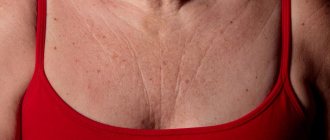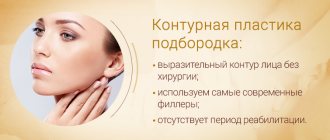After a certain amount of time, the skin of the face loses its firmness and elasticity, and the oval of the face ceases to be clear. The cheeks lose their volume. The corners of the mouth droop down. All these changes do not please us, but on the contrary upset us and give rise to complexes. Both female and male genders suffer from age-related changes. What to do, age makes itself felt.
Previously, to prolong beauty and youth, you would have to visit a plastic surgeon.
Today, new correction methods are used in the field of injection cosmetology.
Facial contouring is an effective solution for eliminating age-related changes. The method is non-surgical and gentle. Has no age restrictions.
Contour plastic surgery can not only eliminate wrinkles and restore youth to the skin, but also make lips fuller, restore volume in the cheekbone area, change the shape of the nose or chin, remove bags under the eyes, and make the look more open.
The advantages of facial contouring will be:
- minimal discomfort;
- absence of scars and cicatrices on the skin;
- execution speed;
- high result;
- fast rehabilitation period;
- natural look;
- long-term preservation of the effect;
Facial contouring is performed using products based on hyaluronic acid, collagen, poly-L-lactic acid, and calcium hydroxyapatite.
The procedure is done in a cosmetology salon after a preliminary diagnosis of the skin.
Preparations for contour plastic surgery
To correct the face, products are used based on:
- hyaluronic acid;
- collagen;
- calcium hydroxyapatite;
- polylactic acid;
Hyaluronic acid is considered the most common tool for facial plastic surgery. When it enters the body, it replenishes the missing volumes and starts the regenerative process.
Collagen fillers quickly restore volume in the desired areas, but can provoke allergic reactions.
When calcium hydroxyapatite enters the body, it begins to act instantly, and the risk of allergic reactions from it is minimal.
Fillers with polylactic acid are good because they have long-lasting results. When injected into the skin, the effects of polylactic acid can last up to 24 months.
Our clinic uses drugs from Pluryal volume and Pluryal classic.
The manufacturer of Pluryal fillers is the European company MD Skin Solutions, which uses modern methods of drug production. MD Skin Solutions has established itself as a global leader among other anti-aging product manufacturers.
Indications for cheekbone augmentation
In addition to personal aesthetic preferences for cheekbone enlargement and the desire for rejuvenation, cheekbone contouring can be performed for the following indications
:
- insufficient expression of cheekbones;
- sagging soft tissues;
- sunken cheeks;
- nasolabial folds;
- nasolacrimal grooves;
- deformation of the oval of the face;
- decreased tone of the dermis;
- congenital and acquired anomalies of the structure of the cheekbones.
Indications for the procedure may include post-traumatic disorders in the area of the zygomatic bone and the consequences of unsuccessful operations in this area.
The difference between contouring and plastic surgery
Features of contour plastic surgery are the non-surgical method. No surgical intervention is used.
The drugs used to correct the zones are compatible with our body and are not perceived as “foreign”; rejection does not occur.
Contour plastic surgery has a minimal percentage of side effects in the form of allergic reactions.
After the procedure, a long recovery period is not required.
Based on the recommendations of the cosmetologist, the patient must follow the following rules: refrain from visiting the bathhouse and sauna for one week and do not sunbathe for 10 days, do not perform facial massage for 2 weeks.
Why is there a need to enlarge cheekbones with fillers?
In cosmetology there is the concept of “triangle of youth”.
This is the visual direction of the vector lines of skin tension on the face. In young people: high cheekbones, a taut oval forming an empirical triangle with a sharp end on the chin. Over time, the proportions of the face change: the muscular frame “falls” down, nasolabial folds appear, the cheeks droop, the corners of the lips, the cheekbones become unexpressed, the triangle changes its direction: an acute angle appears in the forehead area, which visually makes one look very old. Is it possible to return the “youth indicator” to its original position without contacting a plastic surgeon? Yes, you can. In injection cosmetology
There is a technique for contouring and cheekbone augmentation. Contour plastic surgery of the cheekbones allows you to make their outline more expressive. This tactic helps to restore the shape of the oval face.
Contraindications for cheekbone contouring
Contraindications
to change the shape and volume of the cheekbones are:
- age under 18 years (except for medical indications);
- pregnancy and lactation;
- infections and dermatitis of various etiologies in the facial area;
- mental illness;
- violation of hemostasis;
- severe allergy history;
- oncology.
Temporary removal from manipulation can be obtained in the presence of acute respiratory viral infections, exacerbation of chronic diseases, or during menstruation.
Contouring of cheekbones
Before contouring, you must make an appointment with a cosmetologist. The doctor will collect your medical history, find out the presence of contraindications and decide on the need for cheekbone injection surgery. After the interview, the patient’s face is examined, the necessary filler is selected, and its dose is calculated. 24 hours before the procedure, you should not drink alcohol, play sports or take anticoagulants. The procedure is carried out according to the following scheme:
- Cleansing facial skin from cosmetics.
- Carrying out topical anesthesia with lidocaine cream.
- Antiseptic treatment.
- Applying markings for contour plastic surgery.
- Administration of the drug with a thin needle strictly according to the scheme.
- Light massage for optimal distribution of the gel under the skin.
- Repeated antiseptic treatment.
- Applying dermal soothing agents.
At the end of the injections, hyperemia and slight swelling are possible, which will subside after some time without drug intervention. The doctor will provide you with a number of recommendations for further cheekbone care
:
- after the session, be in an upright position and do not touch the zygomatic area of the face with your hands for at least 5 hours;
- do not use cosmetics for a day;
- do not knead the injection areas;
- for the first few days, do not strain your facial muscles;
- Limit visits to saunas, swimming pools and open water bodies for 2 - 3 weeks.
For speedy rehabilitation from edema, you can use Troxevasin cream. Ointments with panthenol contribute to the restoration of the dermis. In order to prevent photoaging, it is necessary to protect the face from ultraviolet rays.
Navigation:
- More details
- Injection procedures for
- How is contouring done?
Cheek contouring refers to the injection of fillers and “beauty cocktails” for the following purposes:
- smooth out wrinkles, folds, eliminate age-related ptosis;
- get rid of acne, pustular rashes;
- even out skin texture, remove acne and scars;
- remove pigmentation and rosacea (“spider veins”);
- model the oval of the face (by “adding” volume);
- correct asymmetry (cheeks of different sizes or shapes).
In a narrow sense, cheek contouring involves modeling the shape or size of the cheeks. Broadly, it also eliminates signs of aging and skin defects.
Injection procedures for cheek correction
Our clinic performs a number of injection procedures of different types: injections with fillers (fillers), Botox and Dysport injections, biorevitalization, Plasma therapy, hyaluronic acid injections, mesotherapy and others.
The choice of a specific injection technique depends on the condition of the patient’s skin and her wishes (what problems she wants to eliminate). Our cosmetologists are very attentive to their patients and do everything possible to ensure that the result of cheek contouring exceeds all expectations.
Please note that some injection techniques require one-time visits to a cosmetologist (for example, Botox, fillers). Others require a course of several procedures at a certain interval (from 3 to 7-8 procedures). The exact amount is announced by the cosmetologist after assessing the condition of the skin.
Wide, low cheekbones don't suit you? This will be corrected by surgery to reduce the cheek bones (reduction malarplasty). 1 day in hospital, 2 months until complete rehabilitation. The result will last a lifetime.
Wide, high cheekbones can be seen on many supermodels - but in real life, those with wide cheekbones are often unhappy with this feature. Why?
The European Cromanoid type with a strong bone structure is characterized by prominent cheekbones, curved at the eye sockets and tapering towards the chin. The upper part of such a zygomatic bone protrudes forward (frontally) from the plane of the face much more than the lower edge. Shaped cheekbones are in demand in the modeling business; they are considered to be a sign of a strong-willed character; in addition, they keep the soft tissues of the cheeks from sagging with age, allowing their owner to maintain the architecture of a youthful face longer.
With the Mongoloid type of face, the cheek bones are also often massive, have a wide and tall body, but lack relief. The zygomatic process of the upper jaw and the zygomatic bone form a single flattened, wide, protruding surface. Protruding wide and flat cheekbones do not create a beautiful, pronounced relief; the face looks massive.
The Renaissance period, when artists and sculptors were interested in mathematics and anatomy, gave us calculations of the ideal proportions of the human body. For the middle third of the face, the ideal width is determined by two ratios:
- the distance between the extreme points of the cheekbones is 4 times greater than the width of the bridge of the nose between the inner corners of the eyes;
- The width of the face between the temples is equal to its width in the region of the mandibular angle and is 10% less than the distance between the edges of the cheekbones.
Previously, owners of large, flat cheekbones could only contour them with a generous layer of decorative cosmetics. Today they offer reduction malarplasty - surgical correction of the width of the face in the cheekbone area. Reducing the cheekbones makes flattened faces more refined, petite and feminine, bringing them closer to classic proportions.
Surgical reduction (reduction) of the cheekbones gives an excellent aesthetic effect on relatively narrow faces, where the area of the cheekbone and zygomatic arch strongly protrudes beyond the boundaries of the ideal oval, while its relief is poorly defined. Since this problem is most typical for the Asian type, South Korea became the pioneer of cheekbone reduction surgery (malarplasty).
Reduction plastic surgery of the cheekbones (Cheek Bone Reduction/Zygoma Reduction) can be performed in three ways:
- cheek bone resurfacing
- osteotomy - excision of a section of the zygomatic bone
- surgical displacement of the zygomatic arch (lateral part of the zygomatic bone and lower part of the temporal bone) inward by dividing into three sections and repositioning
The reduction method is chosen by the surgeon and the patient based on the CT scan data, aesthetic objectives and physiological characteristics of the patient.
Endoscopic malarplasty without repositioning the zygomatic arch is performed under general anesthesia and leaves no marks on the face. It is performed through one incision (in the mouth along the alveolar arch at the level of the incisors) in the case of bone grinding, through three incisions (in the mouth and in the scalp in the area of each temple) in the case of osteosynthesis. The length of the incisions ranges from a few millimeters to 3-5 cm. The risk of damage to the facial nerves during surgery is minimal. In complex cases requiring massive intervention, a combination of malarplasty and endoscopic facelift may be recommended for patients over 30-35 years of age.
The average postoperative hospital stay is 1 day. The active rehabilitation period lasts about 14 days: due to tissue swelling, a compression face mask must be used during this period. As after other operations with intraoral access, after malarplasty there are restrictions on food for some time. Complete facial restoration takes 2-6 months.
In Moscow, malarplasty for aesthetic reasons began relatively recently: unlike South Korean, Singaporean or Chinese surgeons who use standard solutions for pronounced Asian types, Russian specialists work with patients with a mixed type - and for the aesthetic success of the operation an individual approach to each is necessary occasion.
Dr. Guryanov has his own VIP Studio virtual plastic laboratory at his disposal, which allows you to create an individual 3D model based on computed tomography data and three-dimensional light scanning of the face, head and neck. Before malarplasty, the surgeon and the patient plan with high accuracy the desired volume of intervention on a computer model, the system performs calculations, and the result of the operation based on them meets the client’s expectations.










